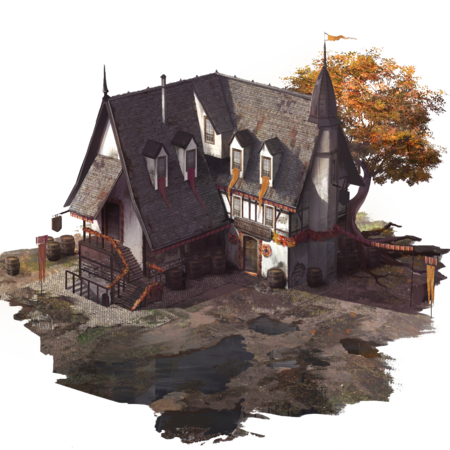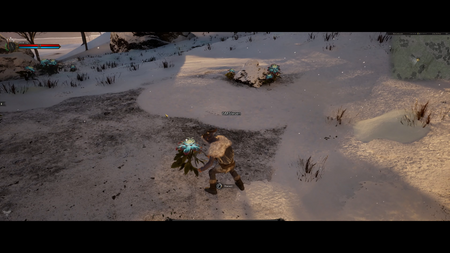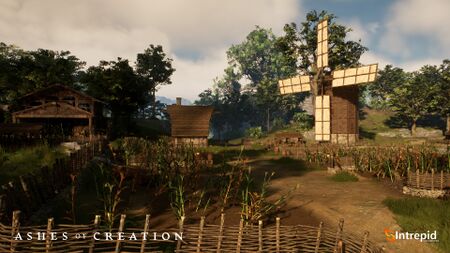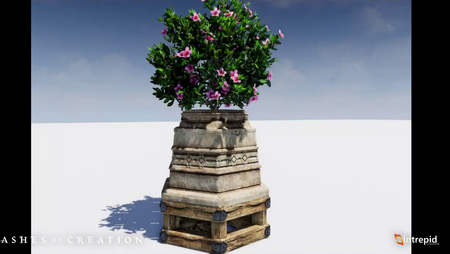Crops
Crops are harvestable resources in Ashes of Creation.[2][3][4][5][6]
- Grundbesitz allow placement of farm workstations for farming crops and livestock.[2][2][3][4][7][6][5]
- The level and types of processing stations on a freehold will affect the speed and quality of crop rotations.[8][2]
- Statische Behausungen allows placement of small garden sections for farming special types of crops.[3][4][9]
- Apartments allow placement of pots to grow seeds.[10][4]
- Public spaces in nodes allow lower-tier animal husbandry and farming activities.[11]
- There'll be different types of tools and/or machinery that can be used to plant multiple seed types within a particular infrastructure that gives you bundles and/or many different harvestings that's part of progression. So, as you get more adept at farming, you have the ability to mass produce; and the same is true when you talk about quantity, speed of processing across many of the different processing professions[8] – Steven Sharif
- Crops are grown from seeds that are obtained from vendors or in the open-world.[12][2]
- Initially seeds will need to be planted individually, but the acquisition of farming tools or hired farmhands will enable more efficient methods.[13]
- Crops must be watered and fertilized until they are mature.[14][12]
- Plants can be uprooted, fruited (seeded), or harvested.[14]
- There are diminishing returns from harvesting crops, where new seeds will eventually need to be reacquired from the world.[15]
- There won't be a breeding mechanic associated with crops.[16]
- Farmable crops have applications beyond basic food items.[17]
- Farmed materials can be processed into craftable materials or be converted directly into consumable items through professions such as cooking and alchemy.[3]

Während viele Familien in dieser Zeit des Jahres bescheidene Zusammenkünfte veranstalten, ist der Schattenlose Baum eine uralte, ehrwürdige Einrichtung, die diese Freude an müde Reisende weitergeben möchte. Hier können Händler, Abenteurer und Bürger, die für das Fest des Grünhüters keinen Platz haben, verweilen, Geschichten austauschen, Lieder singen und Freundschaften schließen. Obwohl die Taverne ohnehin schon ein lebhafter Ort ist, wird sie während der Feierlichkeiten des Wächters besonders belebt, und viele werden aufgefordert, sich den Feierlichkeiten anzuschließen - vorausgesetzt, sie bringen die Taverne nicht zum Wanken.[18]
Die Verdant Hüter... sind eine Sekte von Menschen, die den Überblick über all die Dinge behalten, die für eine erfolgreiche Ernte und den Anbau von Dingen notwendig sind, und die dafür sorgen, dass der Anbau dieser Dinge einer Gesellschaft oder Zivilisation das weitere Wachstum ermöglicht. Beim Übergang von Verra nach Sanctus mussten diese Menschen also neu lernen, wie man Dinge ohne Magie anbaut. Vorher gab es druidenähnliche Menschen, und jetzt müssen wir an einen Ort gehen, an dem es keine Magie gibt, um diese Dinge zu unterstützen. Also verbringen sie ihre Zeit damit, die Welt zu erforschen und sie auf wissenschaftliche Weise kennenzulernen und all diese Jahreszeiten, die verschiedenen Jahre, Jahrzehnte und Jahrhunderte zu beobachten, um eine Art Landkarte für sich selbst und für die Zivilisationen, die sie unterstützen, zu erstellen: Eine Art Instrument, um erfolgreich Getreide anzubauen und die Menschen gesund und glücklich zu halten.[19] – Jeffrey Bard
Während die Monate kommen und gehen und die Hand des Winters sich über das Land legt, nehmen sich die Bauern von Verra Zeit, um das Glück zu feiern, das ihnen der Hüter des Grüns geschenkt hat. Herde werden angeheizt, Kerzen angezündet und duftende Köstlichkeiten zubereitet. Es findet ein großes Fest mit Essen und Trinken statt, das den Höhepunkt der harten Arbeit und der Vorbereitung auf die kommenden harten, kalten Monate markiert. Wenn die Feierlichkeiten gut verlaufen, so heißt es, wird der Hüter das nächste Frühjahr mit einer brandneuen Ernte segnen, die dann gepflückt werden kann.[20]
Seasonal resources

If a particular region moves into a season and that week you can't grow a particular type of good, but another region halfway across the world can grow that good; and you talk about moving those goods across regions so that they're relevant to either craft workbenches or you can sell them in the local economies: That is a major indicator of movement of goods and movement of goods carries risks; and risks can create political foes and friends... Something as simple as just a climate can have cascading consequences across the entirety of the game.[22] – Steven Sharif
Jahreszeiten affect crops and other herbology resources available for gathering or planting, including how crop rotation is managed.[23][24][25][26]
- Seasonal variations in resource availability will impact the economy and necessitate the transit of goods between different regions.[24]
- One of the things that is huge about the season system and how it affects crops and the gatherables in the game is the impact it will have on the economy. When a particular area no longer is capable for a week's period of time, or even potentially longer, of producing a certain type of crop or harvestable; and that has to change across the world regionally, now the transit system of those materials of those gatherables they become more relevant, and they're subject to potential risk; and the prices might go up in certain areas. It is something that is actually very instrumental in the overall design of the economy in the game.[24] – Steven Sharif
- Seasons may not directly affect certain gatherables, such as veins of ore, but access to those resources may be blocked during certain weather conditions.[23][24]
- It won't likely affect too much on certain resource spectrums like veins of ore. Those might not be affected by the seasons or weather systems, but there might be blockages to cave networks that house those types of ore veins. Alternatively it is going to be significant impact on any type of herbology or plant-based types of gatherables. It's going to have significant impacts on crops that players can plant themselves on their properties; and that they'll be able to harvest. They're going to need to time the crop placement and its maturity window so that it's harvestable and available to be harvest before the change of seasons that might adversely affect certain types of crops. And not every biome will experience the same type of effects caused by the seasonality of the world. The desert biome might instead of snow have significant more winds that pick up that could be damaging to more fragile types of crops if you have a freehold in that location.[23] – Steven Sharif
Ressourcen im Unterreich
Ressourcen will be different in the Unterreich, including unique species of fish.[27][28][29]
- This will affect professions such as fishing, farming, and animal husbandry.[27][29]
- Since players may only have one Freehold, they must choose their Artisan specializations accordingly if they wish to place it in the Underrealm.[29]
#REDIRECT MediaWiki:Farmhands/de
Based on node type and progression, players will be able to hire NPCs to work as farmhands on their freehold farms.[30] Players will be able to command these farmhands in-game as well as potentially offline via an application (mobile app) or web interface.[30][31][32]
House plants
- House plants may be available as housing decor items.[4]
- Apartments will allow placement of pots to grow seeds.[10][4]
- Potted plants may yield unique items if the plant is properly maintained.[4]
Siehe auch
Einzelnachweise
- ↑ X.com - Verran screenshots.
- ↑ 2.0 2.1 2.2 2.3 2.4 Video, 2023-06-30 (6:39).
- ↑ 3.0 3.1 3.2 3.3 Interview, 2021-02-07 (42:41).
- ↑ 4.0 4.1 4.2 4.3 4.4 4.5 4.6 Liveübertragung, 2020-10-30 (44:22).
- ↑ 5.0 5.1 Liveübertragung, 2017-05-05 (32:11).
- ↑ 6.0 6.1 Liveübertragung, 2017-05-30 (20:01).
- ↑ Liveübertragung, 2017-10-16 (56:42).
- ↑ 8.0 8.1 Liveübertragung, 2023-06-30 (1:47:33).
- ↑ Liveübertragung, 2020-06-26 (45:32).
- ↑ 10.0 10.1 Interview, 2023-07-09 (41:22).
- ↑ Interview, 2023-07-09 (51:26).
- ↑ 12.0 12.1 Video, 2023-06-30 (11:53).
- ↑ Interview, 2023-09-10 (29:31).
- ↑ 14.0 14.1 Liveübertragung, 2023-06-30 (1:46:24).
- ↑ Interview, 2023-07-09 (55:54).
- ↑ Interview, 2021-02-07 (44:17).
- ↑
- ↑ 18.0 18.1 Ashes of Creation Store: Shadeless Tree Tavern.
- ↑ Liveübertragung, 2019-10-31 (14:13).
- ↑ Blog: Bounties of the Verdant Keeper.
- ↑ Video, 2022-10-28 (19:10).
- ↑ Liveübertragung, 2022-04-29 (56:24).
- ↑ 23.0 23.1 23.2 Liveübertragung, 2022-05-27 (55:47).
- ↑ 24.0 24.1 24.2 24.3 Video, 2022-05-27 (15:50).
- ↑ Liveübertragung, 2017-05-08 (20:27).
- ↑
- ↑ 27.0 27.1 Liveübertragung, 2023-04-07 (27:30).
- ↑ Abschrift, 2022-11-05 (10:46:47).
- ↑ 29.0 29.1 29.2 Liveübertragung, 2017-06-01 (24:30).
- ↑ 30.0 30.1 30.2 30.3 Interview, 2023-07-09 (1:37:34).
- ↑ 31.0 31.1 31.2 Liveübertragung, 2017-05-09 (28:57).
- ↑ 32.0 32.1 32.2 Liveübertragung, 2017-11-17 (11:00).
- ↑ Liveübertragung, 2021-09-24 (1:03:18).


